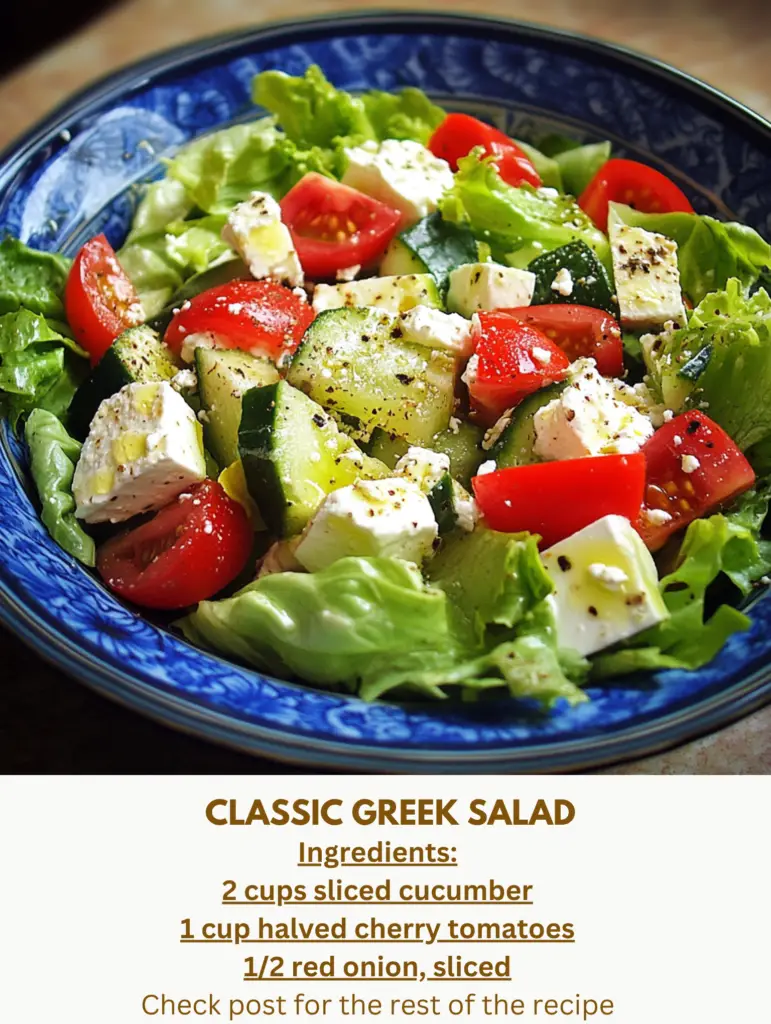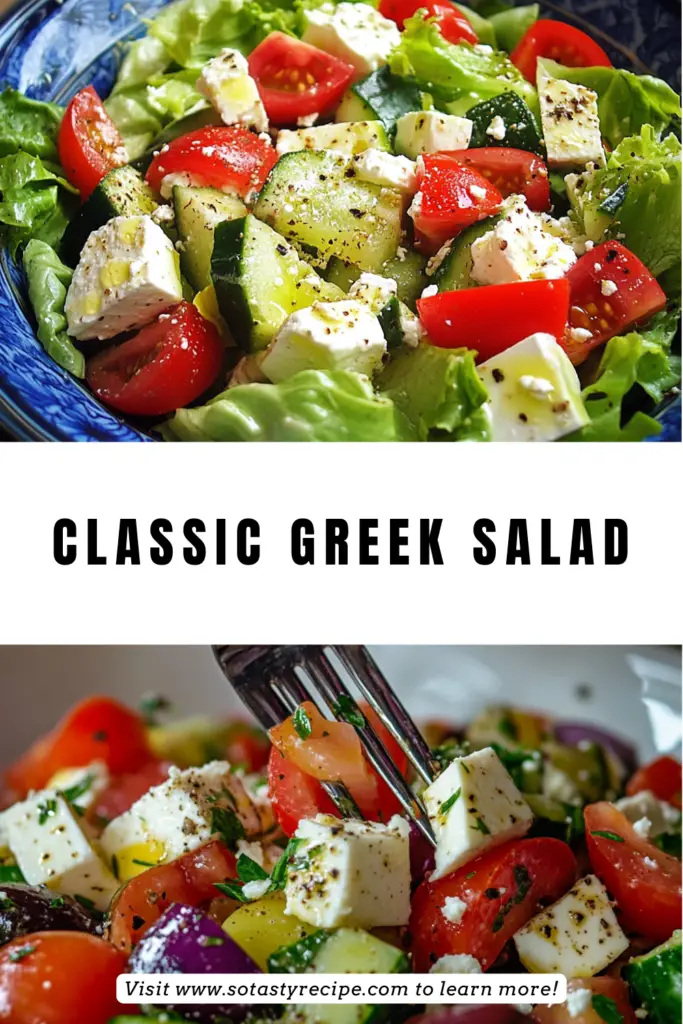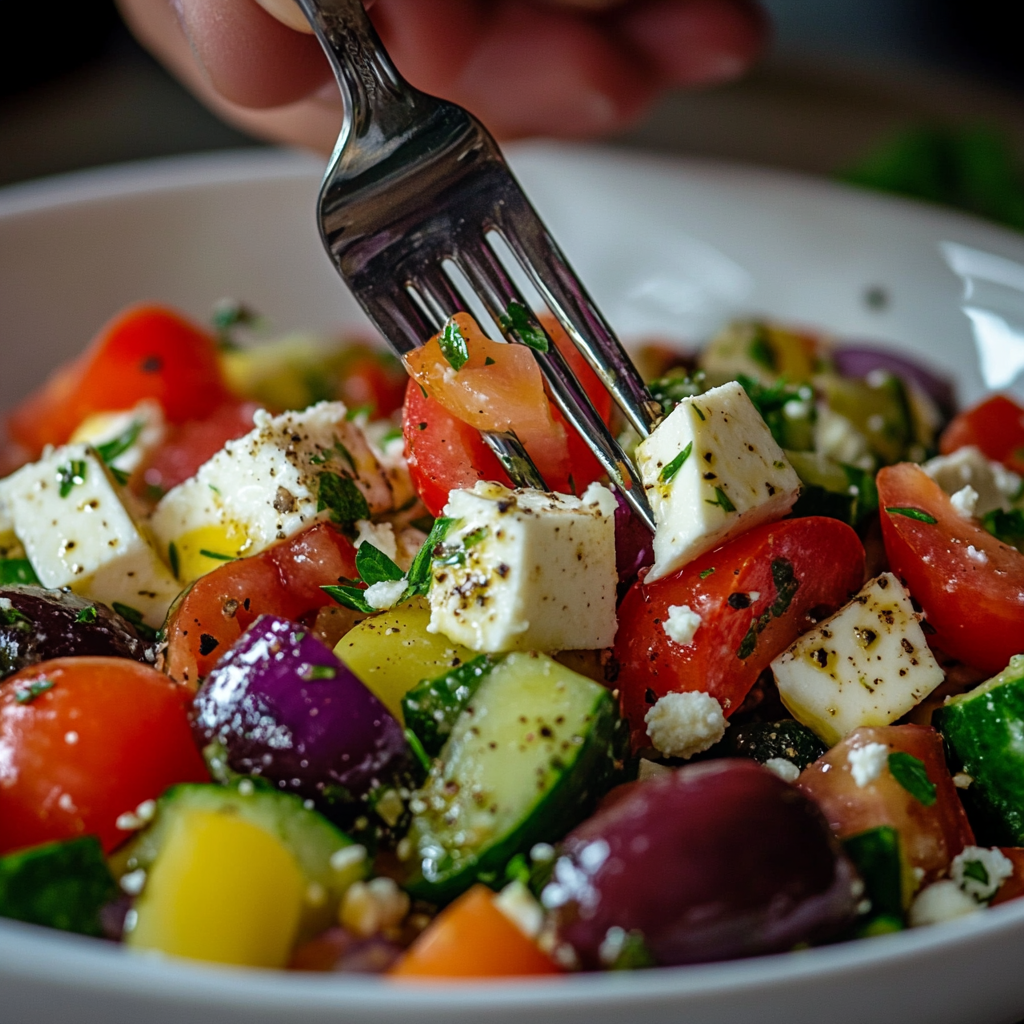Discover the secrets to making the perfect Classic Greek Salad, a refreshing and healthy dish packed with Mediterranean flavors.
Introduction
The Classic Greek Salad is a beloved dish that embodies the essence of Mediterranean cuisine. Known for its vibrant colors, fresh ingredients, and simple preparation, this salad is a staple in Greek households and restaurants worldwide. Whether you’re looking for a light lunch, a side dish, or a healthy meal option, the Classic Greek Salad is a versatile choice that never disappoints.
What is a Classic Greek Salad?
A Classic Greek Salad, or Horiatiki, is a traditional Greek dish made with fresh vegetables, olives, and feta cheese. Unlike other salads, it typically excludes lettuce, focusing instead on chunky tomatoes, cucumbers, red onions, and bell peppers. The salad is dressed with olive oil, oregano, and a splash of vinegar, creating a tangy and flavorful experience.
Origin and History
The Classic Greek Salad has deep roots in Greek culture, dating back to ancient times. It originated in rural villages, where farmers used fresh, seasonal ingredients from their gardens. The simplicity of the dish reflects the Mediterranean lifestyle, emphasizing fresh, wholesome foods. Over time, it gained popularity worldwide, becoming a symbol of Greek cuisine.
Seasonal and Cultural Relevance
The Classic Greek Salad is best enjoyed during the summer months when tomatoes and cucumbers are at their peak. It is a staple at Greek festivals and family gatherings, often served alongside grilled meats and seafood. Its cultural significance lies in its ability to bring people together, celebrating the bounty of the land.

Key Ingredients
The Classic Greek Salad relies on a few key ingredients, each contributing to its unique flavor profile:
- Tomatoes: Use ripe, juicy tomatoes for the best taste.
- Cucumbers: Opt for crisp, seedless varieties.
- Red Onions: Adds a sharp, tangy flavor.
- Bell Peppers: Green or red peppers provide a sweet crunch.
- Kalamata Olives: These briny olives are a must.
- Feta Cheese: Use high-quality, creamy feta for authenticity.
- Olive Oil: Extra virgin olive oil enhances the flavors.
- Oregano: Fresh or dried oregano adds a fragrant touch.
For a halal version, ensure the feta cheese and olives are certified halal.
Preparation Steps
- Chop Vegetables: Dice tomatoes, cucumbers, and bell peppers into large chunks. Slice red onions thinly.
- Assemble Salad: Combine vegetables in a large bowl. Add Kalamata olives and crumbled feta cheese.
- Dress the Salad: Drizzle with olive oil and a splash of vinegar. Sprinkle oregano, salt, and pepper to taste.
- Toss Gently: Mix the ingredients lightly to avoid crushing the vegetables.
Tools and Techniques
- Knife and Cutting Board: Essential for chopping vegetables.
- Mixing Bowl: A large bowl ensures even mixing.
- Measuring Spoons: For precise seasoning.
Variations and Alternatives
- Vegan Option: Replace feta with tofu or a vegan cheese alternative.
- Gluten-Free: Naturally gluten-free, but ensure all ingredients are certified.
- Additions: Include capers, avocado, or artichoke hearts for a twist.
Pairings and Accompaniments
The Classic Greek Salad pairs well with:
- Grilled chicken or lamb.
- Freshly baked pita bread.
- A glass of white wine or a refreshing lemonade.
Comparison with Similar Recipes
Unlike a Village Salad, which may include lettuce, the Classic Greek Salad focuses on chunkier vegetables and a simpler dressing. Its bold flavors set it apart from other Mediterranean salads.
Health and Wellness Aspects
The Classic Greek Salad is rich in vitamins, antioxidants, and healthy fats. It supports heart health, aids digestion, and is suitable for various diets, including Mediterranean and low-carb plans.

Frequently Asked Questions (FAQs)
What is in a classic Greek salad?
A Classic Greek Salad typically includes tomatoes, cucumbers, red onions, bell peppers, Kalamata olives, and feta cheese, dressed with olive oil and oregano.
How long is Greek salad good for in the fridge?
It can last up to 2 days if stored in an airtight container.
What are the characteristics of a Greek salad?
It is known for its fresh, chunky vegetables, briny olives, creamy feta, and simple olive oil dressing.
What is the difference between a Greek salad and a village salad?
A Village Salad often includes lettuce, while a Classic Greek Salad does not.
Best Time to Enjoy the Recipe
This salad is perfect for lunch or dinner, especially during the summer months.
Recipe Evolution
Over time, the Classic Greek Salad has adapted to include modern twists, such as adding quinoa or avocado, while maintaining its traditional essence.
Storage and Leftovers
Store leftovers in an airtight container in the fridge. Avoid adding dressing until ready to serve to maintain freshness.
Presentation Tips
Serve the salad in a large, shallow bowl. Garnish with extra feta and a sprig of oregano for a visually appealing dish.
Cooking for Specific Needs
- Vegan: Use tofu or vegan cheese.
- Gluten-Free: Ensure all ingredients are certified gluten-free.
Fun Facts and Trivia
- The Classic Greek Salad is often served with a slice of bread to soak up the flavorful dressing.
- It is a staple in Greek tavernas, often enjoyed with a glass of ouzo.
Personalization and Storytelling
Add your own touch by incorporating seasonal vegetables or experimenting with different herbs. Share your creations with family and friends to create lasting memories.
Suggested Recipes
For more savory recipes, you can also check my friend Alicia’s blog here.

